The disappearing story of the black homesteaders who pioneered the West
Photo: The historic lunchroom at Dearfield, Colo., is collapsing. (Courtesy of the Black Homesteaders in the Great Plains Proiect)
(The Washington Post) Ever heard of Blackdom in New Mexico? Dearfield in Colorado? What about DeWitty in Nebraska? Didn’t think so. Neither had I several years ago. But they were once vibrant African American homesteading communities. Today their buildings are falling to ruin, their locations are mostly unmarked, and the achievements of their pioneers are mostly forgotten.
These places are precious not just to descendants but to all Americans, and their loss is a national shame. The homesteading story is usually told as one of white Americans’ westward movement. But the 1862 Homestead Act had no racial restrictions, and after the 1866 Civil Rights Act clarified that black Americans were citizens, they too were entitled to 160 acres of public land if they paid a modest fee and lived on the property continuously for five years. (more)
The Jackie Robinson of Rodeo
Five decades ago, Myrtis Dightman broke the color barrier in professional rodeo and became one of the best bull riders who ever lived. But his imprint on the sport was only just beginning.
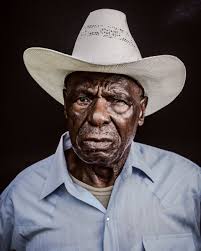
“I don’t have time to fool around,” Myrtis Dightman told a reporter in the summer of 1967. “I want to see a colored man [win].” Photograph by LeAnn Mueller
Pursuing a championship in the world’s most dangerous sport is a formidable task for any cowboy, but for a black cowboy in 1967 such an undertaking seemed, to most, downright impossible. Dightman refused to buy it. “A lot of folks thought rodeo was a white man’s game,” he said years later. “But those bulls don’t care if you’re white or black. You could be green, for all it matters. They just don’t want you on their backs.”
The bulls might have been color-blind, but certain stock contractors and judges were not. Signs posted outside rodeo arenas across the Jim Crow South announced their prejudice in big, bold letters: “No dogs, no Negroes, no Mexicans.” The Civil Rights Act of 1964 had been enacted to snuff out this kind of explicit segregation, yet racism remained rampant. By the 1967 season Dightman had spent nearly a decade “riding the circuit” and had found ways to work around the system. He learned to hold his free hand farther away from his body than the other riders so a crooked judge wouldn’t be able to “foul him out.” He sometimes held on longer than the required eight seconds—just in case the timekeeper’s watch ran a little slow. And he wasn’t surprised when he somehow managed to draw the meanest bulls, the ones thought to be “unrideable,” over and over again. (more)
ACC celebrates renovated, revitalized African American Cultural Center
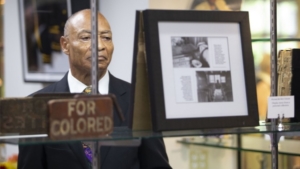
Government student Randy Stripling, 70, views an exhibit Monday after the reopening of the renovated African American Cultural Center on Austin Community College’s Eastview campus. Photo: Lynda M. Gonzalez
(Austin American-Statesman) Austin Community College has completed a renovation of its African American Cultural Center, and a celebration Monday showcased the center’s artifacts as well as palpable enthusiasm about the need for cross-cultural appreciation during turbulent racial times.
The center has existed for years at ACC’s Eastview campus, offering movies, financial aid advice, motivational speakers, various books and periodicals, mentoring, and a place for quiet contemplation.
The renovation enclosed the roughly 850 square feet and added doors that can be locked, thus making it much easier to install valuable artifacts and other exhibits on spruced-up walls and shelves without concern for their security. The cost was nominal because ACC employees did the work, said Molly Beth Malcolm, executive vice president of campus operations and public affairs.
“It’s long overdue but very welcomed,” said Randy Stripling, a semiretired actor, Marine veteran of the Vietnam War and, at 70, one of ACC’s older students. “A place like this will offer comfort and safety, as well as being a repository for educating people.” (more)
TIPHC Bookshelf
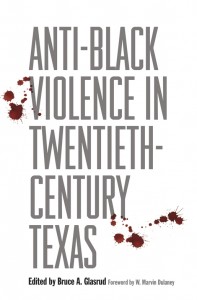 Published scholarship on black history in Texas is growing and we’d like to share with you some suggested readings, both current and past, from some of the preeminent history scholars in Texas and beyond. We invite you to take a look at our bookshelf page – including a featured selection – and check back as the list grows. A different selection will be featured each week. We welcome suggestions and reviews. This week, we offer, “Anti-Black Violence in Twentieth-Century Texas,” edited by Bruce A. Glasrud.
Published scholarship on black history in Texas is growing and we’d like to share with you some suggested readings, both current and past, from some of the preeminent history scholars in Texas and beyond. We invite you to take a look at our bookshelf page – including a featured selection – and check back as the list grows. A different selection will be featured each week. We welcome suggestions and reviews. This week, we offer, “Anti-Black Violence in Twentieth-Century Texas,” edited by Bruce A. Glasrud.
Anti-Black Violence in Twentieth-Century Texas provides an arresting look at the history of violence against African Americans in Texas.
From a lynching in Paris at the turn of the century to the 1998 murder of Jasper resident James Byrd Jr., who was dragged to death behind a truck, this volume uncovers the violent side of race relations in the Lone Star State.
Historian Bruce A. Glasrud has curated an essential contribution to Texas history and historiography that will also bring attention to a chapter in the state’s history that, for many, is still very much a part of the present.
This Week in Texas Black History
Jul 11
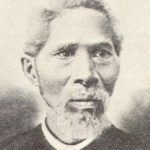 On this day in 1828, Rev. John Henry “Jack” Yates was born into slavery in Gloucester County, Virginia. He moved with his wife (Harriet) and 11 children in 1863 when Harriet’s master relocated with his slaves to Matagorda County. Following emancipation in 1865, Yates moved his family to Houston where he began working with the Home Missionary Society and was ordained a Baptist minister. In 1866, after being ordained, Yates became the first pastor of Antioch Baptist Church, the first black Baptist church in Houston. Yates was also active in education, volunteering Antioch as the site for a Freedmen’s Bureau school and he also helped bring the first Baptist college to Texas, Bishop Academy, an institution that prepared students for employment in trades, business and ministry. Houston’s Jack Yates High School, built in 1926, is named in his honor.
On this day in 1828, Rev. John Henry “Jack” Yates was born into slavery in Gloucester County, Virginia. He moved with his wife (Harriet) and 11 children in 1863 when Harriet’s master relocated with his slaves to Matagorda County. Following emancipation in 1865, Yates moved his family to Houston where he began working with the Home Missionary Society and was ordained a Baptist minister. In 1866, after being ordained, Yates became the first pastor of Antioch Baptist Church, the first black Baptist church in Houston. Yates was also active in education, volunteering Antioch as the site for a Freedmen’s Bureau school and he also helped bring the first Baptist college to Texas, Bishop Academy, an institution that prepared students for employment in trades, business and ministry. Houston’s Jack Yates High School, built in 1926, is named in his honor.
Jul 11-12
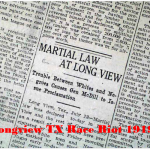 On these days in 1919 the Longview Race Riot occurred, precipitated by an article in the July 10 issue of the Chicago Defender describing the death of a young black man, Lemuel Walters, in Longview. The article, written by Longview teacher Samuel L. Jones, reported that Walters and an unnamed white woman from Kilgore were in love and quoted her as saying they would have married if they had lived in the North. Walters, according to the article, was safely locked in the Gregg County Jail until the sheriff willingly handed him over to a white mob that murdered him on June 17. Jones was held responsible for the article, and on July 10 was accosted and beaten, supposedly by two brothers of the Kilgore woman. News of the article and of the attack on Jones inflamed tempers of both races, and on July 11, a group of twelve to fifteen angry white men drove to Jones’s house where they engaged in a gunfight with residents of the house. Some of the white men went to the fire station and rang the alarm to attract more recruits; others broke into a hardware store to get guns and ammunition. A white mob burned several black homes and a dance hall. Governor William P. Hobby sent Texas Rangers and National Guardsmen to Longview and placed the city and county under martial law. The rangers arrested seventeen white men on charges of attempted murder. Twenty-one black men were arrested, charged, and sent to Austin temporarily for their own safety. Nine white men were also charged with arson. None of the whites or blacks was ever tried.
On these days in 1919 the Longview Race Riot occurred, precipitated by an article in the July 10 issue of the Chicago Defender describing the death of a young black man, Lemuel Walters, in Longview. The article, written by Longview teacher Samuel L. Jones, reported that Walters and an unnamed white woman from Kilgore were in love and quoted her as saying they would have married if they had lived in the North. Walters, according to the article, was safely locked in the Gregg County Jail until the sheriff willingly handed him over to a white mob that murdered him on June 17. Jones was held responsible for the article, and on July 10 was accosted and beaten, supposedly by two brothers of the Kilgore woman. News of the article and of the attack on Jones inflamed tempers of both races, and on July 11, a group of twelve to fifteen angry white men drove to Jones’s house where they engaged in a gunfight with residents of the house. Some of the white men went to the fire station and rang the alarm to attract more recruits; others broke into a hardware store to get guns and ammunition. A white mob burned several black homes and a dance hall. Governor William P. Hobby sent Texas Rangers and National Guardsmen to Longview and placed the city and county under martial law. The rangers arrested seventeen white men on charges of attempted murder. Twenty-one black men were arrested, charged, and sent to Austin temporarily for their own safety. Nine white men were also charged with arson. None of the whites or blacks was ever tried.
Jul 15
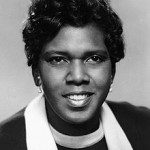 Texas Congresswoman, Barbara Jordan, became the first African-American to give the keynote address at a major national political convention by giving a keynote address at the Democratic National Convention on this date in 1976 in New York City. In opening her remarks, Jordan noted the significance of her appearance: “…my presence here is one additional bit of evidence that the American dream need not ever be deferred.” Jordan was a Houston native and graduate of Phillis Wheatley High School and Texas Southern University.
Texas Congresswoman, Barbara Jordan, became the first African-American to give the keynote address at a major national political convention by giving a keynote address at the Democratic National Convention on this date in 1976 in New York City. In opening her remarks, Jordan noted the significance of her appearance: “…my presence here is one additional bit of evidence that the American dream need not ever be deferred.” Jordan was a Houston native and graduate of Phillis Wheatley High School and Texas Southern University.
Blog: Ron Goodwin, Ph.D., author, PVAMU history professor
Ron Goodwin is an assistant professor of history at Prairie View A&M University. Even though he was a military “brat,” he still considers San Antonio home. Like his father and brother, Ron joined the U.S. Air Force and while enlisted received his undergraduate degree from Texas Lutheran University in Seguin, Texas. After his honorable discharge, he completed graduate degrees from Texas Southern University. Goodwin’s book, Blacks in Houston, is a pictorial history of Houston’s black community. His most recent book, Remembering the Days of Sorrow, examines the institution of slavery in Texas from the perspective of the New Deal’s Slave Narratives.
Recent Posts
King of Kings
During his lifetime Martin Luther King consistently paralleled the experiences of the biblical Children of Israel and the experiences of Africans in America. As a result, he thrust himself into the role of Moses. What I find interesting in these parallels was the ultimate goal of the story. The Children of Israel, after 400 years of bondage, eventually made their way to the Promised Land. This was the message that I believe King was ultimately…
Wakanda Forever — Part 2
The internet records the following regarding the financial success of the Black Panther as of March 25, 2018: Receipts grossed $631.4 million in the US and Canada and a worldwide total of $1.239 billion; The film made $370.5 million worldwide in its opening weekend (the 15th largest of all time); Thus far, Black Panther is the highest-grossing solo superhero film and the 3rd third highest-grossing movie in the Marvel Cinematic Universe (MCU); and In only five weeks after…
Submissions wanted
Historians, scholars, students, lend us your…writings. Help us produce the most comprehensive documentation ever undertaken for the African American experience in Texas. We encourage you to contribute items about people, places, events, issues, politics/legislation, sports, entertainment, religion, etc., as general entries or essays. Our documentation is wide-ranging and diverse, and you may research and write about the subject of your interest or, to start, please consult our list of suggested biographical entries and see submission guidelines. However, all topics must be approved by TIPHC editors before beginning your research/writing.
We welcome your questions or comments. Please contact Mr. Michael Hurd, Director of TIPHC, at mdhurd@pvamu.edu.
